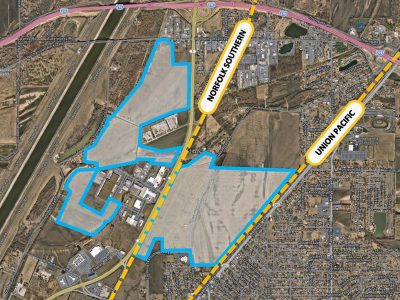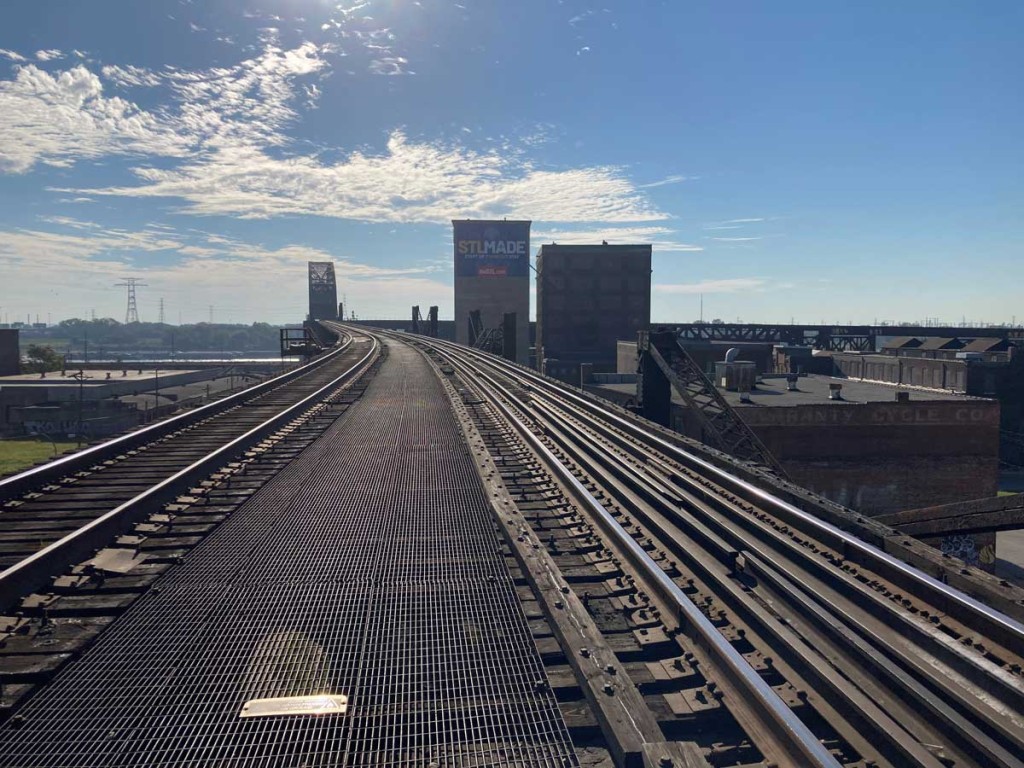
The St. Louis Regional Freightway has added another top rail-accessible industrial real estate site to its pipeline: RTE 3 Industrial. The 715-acre site is located in Granite City, Illinois, along the Illinois Route 3 industrial corridor. It joins an existing pipeline of 11 rail-served sites featuring heavy industrial user zoning ready for developers who want to take advantage of the strong rail infrastructure that is constantly being improved, along with a host of other multimodal advantages in the bi-state area.
The new RTE 3 Industrial site lies in the heart of the Illinois Route 3 corridor between downtown St. Louis and Interstate 270, which is the backbone of a 60-mile-long logistics and manufacturing corridor with access to all six Class I railroads, five airports, four interstates, and one of America’s largest inland ports. With an accessible and highly skilled workforce of employees from three states, existing sites with heavy infrastructure already in place, and a successful pro-business, pro-growth climate, the Route 3 corridor is optimal for manufacturing and logistics and reduces location costs for many manufacturers.
There are three sites within RTE 3 Industrial: East Site, West site and Northgate Site. All are zoned as M4-Planned Industrial and have TIF, Enterprise Zone and Foreign Trade Zone incentives available. The East Site has rail access via Norfolk Southern and Union Pacific. In addition, each location is divisible, levee protected and contains utilities at or near the site. The East, West and Northgate Sites are 392 acres, 249 acres and 73 acres respectively. Site plans show potential buildings ranging from 290,000 SF to more than 1,000,000 SF.
Rail distribution continues to grow in importance, with the Federal Highway Administration estimating that the industry will increase 30% over the next two decades. The St. Louis region already is recognized as one of the largest rail hubs in the country and is taking steps now to take advantage of this projected growth by focusing on new industrial development within rail-accessible land sites, while simultaneously investing in strengthening existing rail infrastructure. Rail service and infrastructure in the St. Louis region is continuously improving, thanks to the commitment of public and private leaders who are collaborating to identify priority projects and advocate for funding for them.
The most recent notable improvement is the new $222 million Merchants Bridge -- a vital rail artery across the Mississippi River linking Missouri and Illinois at Downtown St. Louis, and one of the nation’s primary east-west rail corridors. Work to replace the original bridge, owned by Terminal Railroad Association (TRRA), was completed in September 2022. The new double-track bridge can facilitate two freight trains moving in opposite directions at the same time and move freight faster, more cost-effectively and more reliably, providing an alternative to more congested rail hubs like Chicago. The added capacity helps reduce the frequency of mile-long blockages along the St. Louis Riverfront and addresses one of the chokepoints in the nation’s supply chain network, positioning the St. Louis region to accommodate growing freight demands. TRRA anticipates the region will see more than $370 million in operational savings from reductions in delays, rerouting and operations and maintenance.
“I am confident the economic benefits of this new bridge will be long-lasting,” said TRRA President Brent Wood.
Work is now underway on a $57.6 million project to rehabilitate the nearby MacArthur Bridge. It is located south of the Merchants Bridge in downtown St. Louis and is the fourth busiest Mississippi River railroad crossing in the U.S. Another project in the planning stages focuses on upgrading the St. Louis Multimodal Madison Rail Yard that is part of the Terminal Railroad system. Originally built to handle trains up to 3,000 feet long, the improvements will enable TRRA to more efficiently handle today’s larger freight trains that typically range from 7,000 feet to 14,000 feet long. Yet another project calls for improvements to the Illinois Transfer 3rd Main Railroad Track. That will deliver fewer blocked grade crossings for shorter periods of time, less wasted locomotive emissions due to idle trains, higher utilization of the region’s Mississippi River intermodal ports, and create more jobs due to the ability to more efficiently process freight in the St. Louis region.
The two-state St. Louis region’s intermodal capabilities and rail proximity to both regional and national customers and suppliers supports manufacturing and distribution growth in the nation’s heartland. Rail freight can be transloaded to truck and shipped in one day from the St. Louis area to mega manufacturing regions like Chicago, Kansas City, Missouri, Memphis and Nashville, Tennessee, Columbus, Ohio, and Louisville, Kentucky. Accessibility to other modes, such as barges along the Illinois, Missouri and Mississippi Rivers, provides additional benefits for barge/rail transload services. The St. Louis region is the most strategic location on the Mississippi River because it is ice free and lock free all the way to the Gulf of Mexico. It is the most efficient inland port in the nation in terms of cargo tonnage moved, and it is branded as the Ag Coast of America due to being home to the highest agricultural and fertilizer barge handling capacity anywhere along the Mississippi River.
A series of projects underway at St. Louis area ports also are enhancing rail infrastructure and helping increase the integration of barge to rail connectivity that provides cost-effective freight transportation capacities, resiliency and redundancy. At America’s Central Port in Granite City, Illinois, for example, recent grants have supported multi-million dollar projects to install more than 2,000 feet of new railroad track, install a new product receiving belt system from barge to rail, and support railcar load-out upgrades and the modernization of multimodal transfer equipment.
“All this funding that's been coming for our port facilities has just been tremendous, and I just can't thank enough those who are now realizing the importance of ports throughout the country,” said Dennis Wilmsmeyer, Executive Director at America’s Central Port.
Mary Lamie, Executive Vice President of Multimodal Enterprises for Bi-State Development and head of the St. Louis Regional Freightway, says the St. Louis region’s continued investment in rail infrastructure improvements benefits all modes of transportation, and supports the St. Louis Regional Freightway’s strategic initiative that is helping advance underutilized sites that support industrial development.
“This continuing public and private sector collaboration is essential to the ongoing efforts that are helping to transition vacant abandoned industrial sites into developable, ready-to-market sites,” Lamie said.







